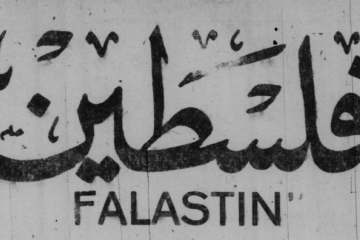
Visual and historical resistance: Digital museum Collecteurs launches online exhibition 'Falastin' dedicated to the Palestinian cause

Launched last month by the digital museum Collecteurs, Falastin is a new online exhibition showcasing a timeline of Palestine’s history, accompanied by visual artworks, essays, videos, photography, and poetry.
The first chapter of the exhibition, Multiculturalism Before the West, is dedicated to the cultural mosaic that existed before the arrival of the West into the region.
It features contributions by Claire Fontaine, and Rashid Khalidi, among many other individual artists and collectives.
During the coming months, the exhibition will unfold chapter by chapter on the Collecteur’s website and Instagram, documenting the history of Palestine from the late 19th century to the present, alongside artistic responses that relate to the themes explored.
|
|
Evrim Oralkan, founder of Collecteurs and co-curator of the first chapter of Falastin, explained to The New Arab that the project was born out of a disappointment towards the stance art institutions have taken since the war in Gaza broke out.
“The majority of the art institutions have failed us. It’s a disaster,” said Oralkan.
"The consequences for those who have taken a stance in support of Palestine have been severe"
According to Evrim, institutional silence has been a prevalent issue. From the cancellation of exhibitions to outright firing individuals, such as in the case of ArtForum’s Chief Editor, David Velasco, the consequences for those who have taken a stance in support of Palestine, have been severe.
This has created an environment where artists and practitioners who want to express their support for Palestine feel unsafe to do so.
“Falastin was born to fill that void. We wanted to create a voice that people can follow,” Evrim revealed.
This is intrinsically connected to the true purpose of art, as Evrim explains, “Artists are those who speak up under any circumstance. It was very clear that if Collecteurs didn't do this, there would be no art world left for any of us to inhabit.”
Over the past six months, Israel's brutal war on Gaza has dominated social media feeds, overwhelming users with the reality of what is going on through the distressing content.
This experience, particularly for those directly impacted by the genocidal war, has led to trauma and a desire for online spaces curated with sensitivity.
In many ways, Falastin strives to meet this need by blending historical context with beautiful and poignant pieces of art.
Even though the narrative follows a clear-cut structure, engagement with Falastin never feels repetitive, as each artwork creates stimulating breaks that invite the viewer to reflect and engage emotionally while learning about the history of Palestine.
Such an example can be seen in the exhibition that juxtaposes the history of the Jaffa orange with Sondos Azzam’s 'Nāranga,' a piece that explores the fruit's symbolism in Palestinian culture through a culinary lens.
Sondos Azzam's autobiographical perspective adds depth, portraying the orange as a powerful emblem of resilience and hope.
that explores the collective memory of the Jaffa orange
[Courtesy of Sondos Azzam]
For Evrim, the historical timeline is the most important aspect of the project — through this people can learn about what happened in the past to understand and inform what is happening in the present.
“We wanted to bring historical information to inform and educate, and ultimately to save lives,” Evrim explained.
Lebanese artist Lamia Joreige's Uncertain Times documents the last days of the Ottoman Empire (1913-1920) to uncover how the uncertainty experienced then may be linked to the present and future of Syria, Lebanon and Palestine.
Ultimately, through this awareness and knowledge, Falastin aims to “touch on people’s emotions and inspire them to take action.”
Resistance is weaved into every part of the project, including its means of production.
The project was solely run by over 300 volunteers, who used digital spaces to share resources, to organise and build the exhibition in less than four months.
Curator, writer, and researcher Rana Anani’s contribution to Palestinian identity provides an unmatched depth to the exhibition’s overarching narrative, which was translated from Arabic by the people in the group.
The Institute for Palestine Studies (IPS) and the international collective of worker-activists Working Class History were also involved in the making, providing Collecteurs with resources, including unrestricted access IPS archive.
“It was a collective effort, fuelled by the realisation that doing this would open many doors,” said Rana.
[Courtesy of Lamia Joreige]
The Falastin team is actively collaborating with Palestinian artists, providing them with the necessary support and guidance to join the project, although it's challenging.
"There are so many Palestinian artists who want to join. However, a lot of them are worried, especially those who have close family members still living in the region," Evrim explains.
forming part of the Falastin exhibition
The coming months will be busy for the Collecteurs team. There are five chapters more to be released in the exhibition, including the final one titled Combatting Erasure: The Future of Palestine which, Evrim explains, “will take a different tone, as it will imagine a future for the land of Palestine.”
Moreover, discussions are underway with a representative from a Middle Eastern Arabic country in the UN to host the project.
However, the primary focus for Collecteurs will be on community-building and encouraging as many people as possible to let the project take its own collective course.
Evrim emphasises the importance of spreading the message: "It's crucial for us to show that it's possible to take action now. If we can do it, why not you?"
The current and upcoming chapters of the Falastin exhibition can be viewed here.
Luisa De la Concha Montes is a freelance writer and content creator
Follow her on Instagram: @erst.while / @icon__clas




